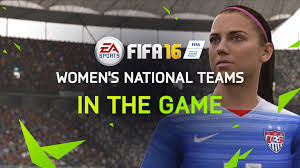By Ben Nicholson
September 21 – A week prior to the release date of videogame FIFA 16, some female national team players have been reluctantly removed from the game for precautionary reasons.
The fear was that these players would lose their eligibility to play for NCAA (National Collegiate Athletic Association) universities in the US.
The NCAA has strict rules requiring that all athletes competing in the division be of amateur status. Their mantra is: “students first, athletes second.”
To retain amateur status athletes must fulfill an extensive list of requirements, including never having signed a contract with a professional team and never having received a salary for participating in athletics.
At issue for FIFA 16 purposes is the requirement that athletes must have not receive compensation for media appearances that exploit their athletic ability or fame.
The NCAA informed EA Sports that 13 student-athletes would be at risk if their likeness were used for the game.
EA Sports responded: “We do not agree with this position. All rights were secured following standard protocol with national governing bodies and federations, and none of these NCAA student-athletes or potential student athletes were to be individually compensated by EA SPORTS for their inclusion in the game.”
However, they ultimately waived their objections: “We believe this decision denies these 13 athletes the opportunity to represent their countries in the game, but we have removed them from FIFA 16 to ensure there is no risk to their eligibility.”
Interestingly, none of the players at risk were actually from the US. The list comprises of six Canadians, six Mexicans and one Spaniard. Of the 13, two were 17 years old and not even in college yet.
This incident speaks to a wider controversy prevalent in the U.S. about NCAA amateur-status. There is discontent about the NCAA’s ability to profit from university students without paying them.
In 2013 the NCAA brought in reported revenue of $918.2 million. This is driven by basketball and American football, and the money is used to subsidise less profitable sports, in the US, like soccer.
Some feel that the athletes should receive some of this money. It should be noted, though, that some athletes do gain some, and sometimes a tremendous amount, of monetary benefit already by way of scholarship.
The top recruits in top teams – those who are driving the competitiveness of the sport and the retail abilities of it – oftentimes have full rides (scholarships) that can cover tuition fees around the $55,000 per annum mark.
The national players, in this instance, appear to gain no financial benefit from their inclusion in the game but are now deprived the historic recognition of appearing as the first female inclusions in the videogame franchise.
Without passing judgment on the merits of the aforementioned debate, and NCAA’s intentions, this is a further grievance that does not serve to improve its popular image.
Contact the writer of this story at moc.l1745221991labto1745221991ofdlr1745221991owedi1745221991sni@n1745221991osloh1745221991cin.n1745221991eb1745221991

